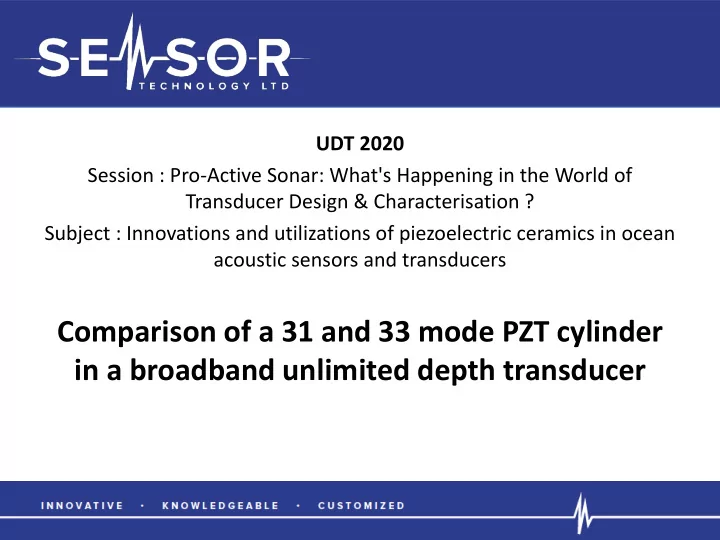

UDT 2020 Session : Pro-Active Sonar: What's Happening in the World of Transducer Design & Characterisation ? Subject : Innovations and utilizations of piezoelectric ceramics in ocean acoustic sensors and transducers Comparison of a 31 and 33 mode PZT cylinder in a broadband unlimited depth transducer
Introduction Send-Receive Transducer Applications – Underwater communications – Beacons – Range Tracking – Acoustic Triggers
Introduction Send-Receive Transducer Requirements – Low Frequency Broadband (8-14kHz) – High Pressure – Hemispherical Beam
Approach PZT material selection Conceptual Design FEM Modelling Assembly
Approach
Approach PZT material selection Navy Type I Navy Type III (BM402) (BM800) Relative dielectric consant 1350 1000 Dissipation factor (%) 0.4 0.3 d 33 (10 -12 C/N) 305 225 k 33 0.71 0.64 k p 0.60 0.5
Approach Conceptual Design -High (Unlimited) Depth Options Free Flooded Ring – toroidal beam pattern Oil-Filled
Approach Conceptual Design PZT ceramic in 31 mode (classic inside/outside electrodes) PZT ceramic in 33 mode (striped electrodes), offering higher K and g33
Approach Conceptual Design -High (Unlimited) Depth Options Oil filled transducer – hemispherical beam pattern
Approach FEM Modelling
Approach FEM Modelling
Approach Assembly of Transducers a)Free Flooded Ring, 31 mode cylinder b) Oil Filled Transducer, 31 mode cylinder c) Oil Filled Transducer, 33 mode cylinder
Results
Results
Results Beam Pattern XY Radial Plane
Results Beam Pattern XZ Axial Plane
Future Work • Sea Trials • Turning the aspect ratio of the cylinders, to further couple the 8kHz Helmholtz resonance with the 13kHz radial resonance • Scaling the design, using same principle design for lower or higher frequencies
Recommend
More recommend